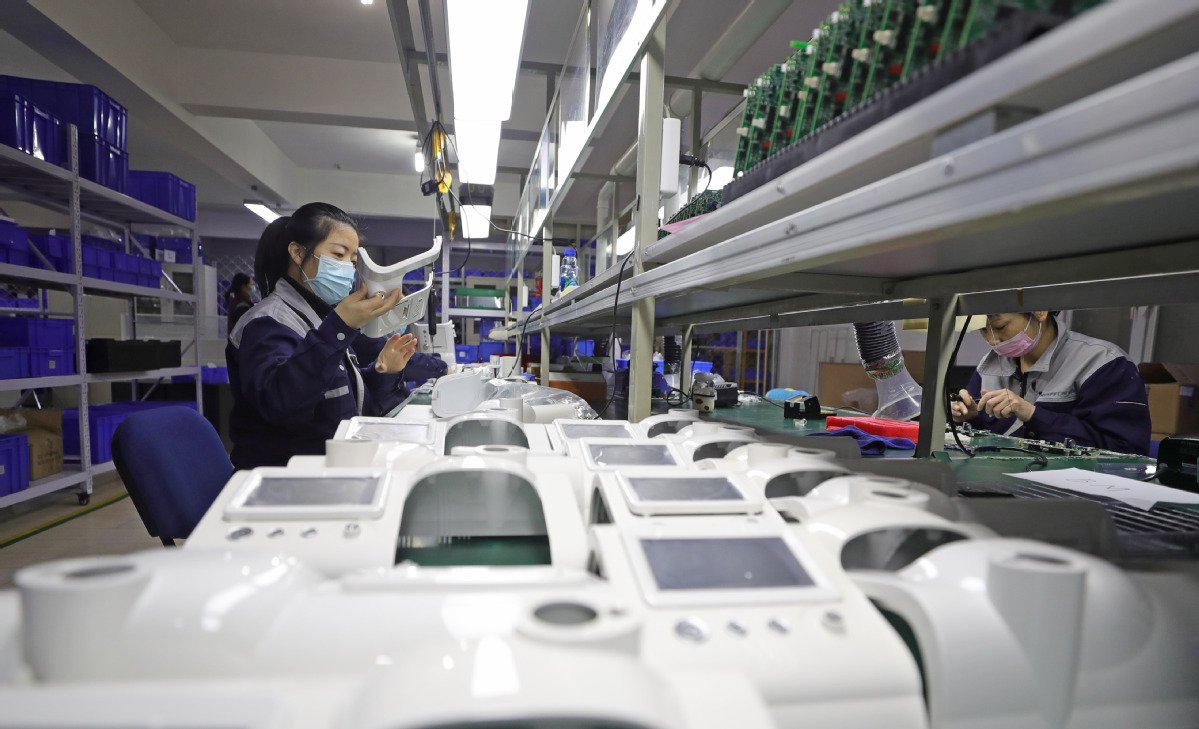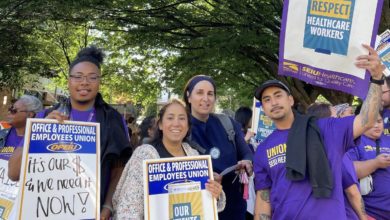
The $2 trillion relief bill of spending and tax breaks to bolster the hobbled U.S. economy hard hit by the COVID-19 pandemic was signed into law on March 27. While offering some relief to workers, it does little to directly address broken supply chains for vital items like ventilators. It does not require manufacturers to coordinate production of equipment and therapeutics in short supply, or ensure that masks and ventilators are distributed to where they’re most needed.
It does, however, offer bonanzas to corporations. The federal government is open for coronavirus business, and the race to get some of the $2 trillion has become a frenzy. Lobbyists are descending on Washington seeking lucrative contracts. Some are advocating for companies producing a mist spray for killing the virus on airplanes, others for recyclable hospital curtains, still others for a host of disinfectants competing against each other. Companies making test kits and masks are also in competition.
Ventilators are the most the most important piece of equipment for keeping COVID-19 patients in crisis alive. Yet there is an acute shortage. New York State, overwhelmed with with 60,000 virus cases and 1,000 deaths, has made an urgent plea to the White house for 30,000 ventilators. In New Orleans, where there has been a surge of COVID-19 cases, Gov. John Bel Edwards warned that the city could run out of ventilators in days.
Why weren’t ventilators and personal protective equipment prioritized in the $2 trillion bill? Why weren’t they produced and stocked two months ago when the alarm was sounded that the virus would affect the United States? Why is there no federal plan to fight the virus?
The Trump administration has had the authority to invoke the Defense Production Act, a 1950 law which allow him to harness U.S. factories, and to organize, centralize and prioritize production of what is needed in time of crisis. Trump could have re-fitted factories for producing ventilators and their parts, even compelling competing companies to work together for rapid and streamlined production.
Biggest businesses said ‘no’ to Defense Production Act
He hasn’t done this because Wall Street is against it. For weeks the U.S. Chamber of Commerce has strongly lobbied the government against using the Defense Production Act because invoking and implementing it would cut into their profit margins. The Chamber of Commerce represents the interest of the largest U.S. corporations, the ones whose very existence defines the world “capitalism.”
The Trump Administration is listening to Wall Street, not the needs of the people. Following the instructions of the Chamber of Commerce, the U.S. government has opted for “corporate volunteering.” The argument is that, through the magic of the marketplace, corporations will automatically, on a voluntary basis, produce what is needed for the COVID-19 crisis, and make money too.
But corporations are making money not by mass producing what is needed, but by jacking up the prices of the scarce supplies that already exist, making the crisis much worse. The Trump administration has the authority to stop this price-gouging, but it has not.
The current health crisis has exposed the bankruptcy of the capitalist system and the state that serves it. The crisis has shown that a system obsessed with profits is neither willing nor able to meet the needs of the people no matter what the cost in human lives.
New York a test case for rest of country
The need for PPE and especially for ventilators is there for all to see. With 40 percent of the country’s virus cases, on March 24 New York State Governor Andrew Cuomo made an impassioned and urgent plea to the federal government for as many ventilators as can be found, calling the need “critical and desperate.”
New York State, has 7,000 ventilators, Cuomo said, but needs 30,000. New York City Mayor Bill De Blasio has said that 15,000 are needed for NYC alone, which has the most cases in the country. The state had received only 400 ventilators from the federal government.
The shortage of life saving equipment is so acute that on March 26, New York approved an experimental technique of putting two persons on one ventilator because “we have no alternative,” said Cuomo. Veterinary hospitals and schools are donating their ventilators for human use.
U.S. cities short 135,000 ventilators
Other cities see in New York what could happen to them down the road. A March 24 survey by the U.S. Conference of Mayors found that 192 cities didn’t have needed supplies to fight the virus. The cities need 135,000 ventilators, 28.5 million face masks, 24.4 million other items of personal protection equipment, 7.9 million test kits and more. Counted were PPE items needed just for health care personnel. Many thousands more workers need masks and other equipment because they come in direct contact with the public.
Competition between states raises prices for PPE
There is no central coordination for getting supplies. The states have been advised by the federal government to buy ventilators and PPE on the open market. This has forced states to compete against each other for what exists. Corporations have responded to the demand by jacking up prices.
“Price gouging is a tremendous problem, and it’s only getting worse,” Cuomo said. The cost of a single ventilator has risen from $25,000 to $40,000. Face masks for front-line staff, normally about 58 cents each, have been quoted by sellers at $7.50, according to Cuomo’s office. Thermometers are going for twice their usual price, latex gloves triple. Portable X-ray machines that help diagnose the virus cost as much as 20 times what they were selling for before the emergency.
Why cooperative production needed
Centralization and prioritization of production is needed to save lives. Laws are needed to punish those who price gouge. This could be done under the Defense Production Act. After waffling, Trump finally invoked the DPA on March 27, but only regarding one company, GM, which had already agreed to produce ventilators. This is merely giving lip service.
With cities needing at least 135,000 ventilators right away, GM said it could only ship by April or May, and then only 5,000 to 7,500 units. These ventilators would not reach the cities in time for this first, devastating wave of the virus.
If seriously invoked two months ago, the Defense Production Act could have re-tooled and re-directed thousands of plants, and found domestic substitutes for components made overseas.This would have been most helpful for complex goods such as ventilators, which are assembled from hundreds of individual parts.
But the Trump administration sat on its hands.
Workers take initiative: Find supplies; demand refitting to make ventilators
With the federal government so derelict in its duties, working people and their unions have have filled the gap. Presidents of the Service Employees International Union, the American Federation of State, County and Municipal Employees, the American Federation of Teachers and the National Education Association wrote a letter to Chamber of Commerce CEO Tom Donohue on March 29:
“We condemn the Chamber’s efforts to lobby President Trump against using the Defense Production Act to direct emergency production of life-saving PPE and medical equipment such as ventilators….The idea that the Chamber would put bottom-line profits and adherence to some mistaken principle of capitalism ahead of the safety of American workers and the public at large is difficult to fathom.”
Service Employees International Union United Healthcare Workers West, concerned with their members’ safety, has located 39 million N95 masks and is making them available to state and local governments and health care systems. The union found a supplier that can produce 20 million protective masks per week and another that can supply millions of protective face shields.
Workers at General Electric’s Lynn, Massachusetts factory walked off the job on March 30 to demand that the company stop making jet engines at the plant and make ventilators instead. They were backed by their union, the Communication Workers of America.
Socialist planning needed
Unable to get ventilators in the U.S., New York State has purchased 15,000 ventilators in China. Why does China have ventilators when the U.S. doesn’t?
China has ventilators because, while there are capitalist businesses there, China has the centralized government of a socialized country. This government prioritized meeting human needs and saving human lives. In marked contrast to the U.S foot-dragging, when the seriousness of the virus became evident, the Chinese government immediately centralized the retooling of more than 1,000 factories to produce needed supplies. Applying science and the principles of public health, China has contained COVID-19. Now it is producing for export many thousands of ventilators, masks, gowns, test kits and other PPE , often given these as gifts to countries hardest hit.
Cuba, a socialist country whose government puts people’s needs first, instituted science-based practices to protect its population. It has very few COVID-19 cases, and is sending anti-viral medications and doctors around the world to assist other countries.
The coronavirus pandemic has revealed the capitalist system to be so bankrupt that, for the sake of humanity, it must be put out if its misery. Capitalism is the virus and socialism is the cure.





